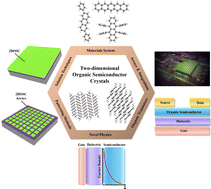Novel solution-processed 2D organic semiconductor crystals for high-performance OFETs
Abstract
Two-dimensional (2D) organic semiconductor crystals (OSCs) have the advantages of ultrathin thickness, long-range ordered molecular structures, the absence of grain boundaries, and low defect and impurity densities, and they are of great significance for revealing the charge transport mechanism of OFETs, achieving efficient charge injection and transport, and preparing high-performance devices. However, the preparation of large-area high-quality 2DOSCs and investigation of their intrinsic properties remains challenging; especially, fabricating 2DOSC arrays is indispensable for integrated applications. Herein, we first carefully review the solution-processed materials and techniques for fabricating 2DOSCs and 2DOSC arrays because of their low-cost large-area preparation capability. Then, we discuss the novel physical and electronic properties of 2DOSCs at the 2D limit. Furthermore, we summarize recent advances in high-performance OFETs based on 2DOSCs and corresponding heterojunctions. Their device arrays and integrations for practical applications are also highlighted. Finally, the pivotal challenges and future opportunities that include the fundamental investigations and practical application of 2DOSCs are listed. These summaries highlight the scientific significance of this field; can help researchers to improve the efficiency of literature retrieval in this rapidly developing field; provide some references for practical applications; and will attract more researchers, engineers and entrepreneurs with backgrounds in physics, chemistry, materials and microelectronics to join the research and development of 2DOSCs, OFETs, and circuits.

- This article is part of the themed collections: 2024 Materials Chemistry Frontiers HOT articles and 2024 Materials Chemistry Frontiers Review-type Articles


 Please wait while we load your content...
Please wait while we load your content...